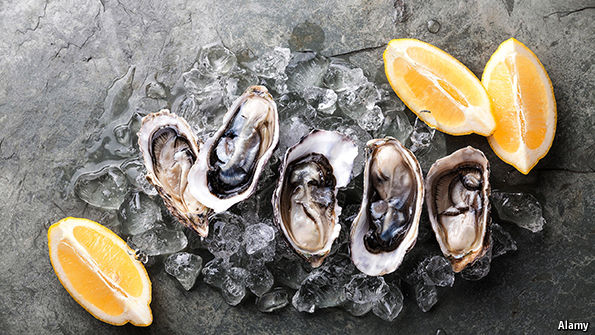Food safety
Particle biology
A better way to avoid shellfish poisoning
Oct 10th 2015 | From the print edition
来源:Economist
翻译:Z.K.

Guaranteed dinoflagellate-free
FILTER-FEEDING bivalve molluscs, such as mussels, oysters, scallops and clams, are a useful and tasty source of protein. They can, though, also be harbingers of illness. A filter-feeder lives, as the name suggests, by trapping and consuming particles (mostly bacteria and single-celled algae) suspended in water it pumps through its body. If those particles are themselves toxic, they can seriously discomfort, and occasionally kill, a human who eats a mollusc that has been feeding on them.
滤食性双壳贝类如贻贝,牡蛎,扇贝和蛤蜊都是营养且美味的蛋白质来源。但是同时它们也预示着疾病。滤食性贝类,顾名思义,通过捕获悬浮在水中的微生物(大多细菌和单细胞藻类)为生。如果这些微生物本身是有毒的,那么如果人吃了由这些微生物饲养的软体动物,可能会造成严重不适,甚至致死。
The most common culprits are algae called dinoflagellates and diatoms, several species of which make potent toxins. These algae often multiply into spectacular blooms along coastlines. Even in the absence of such a bloom, though, they can be abundant enough to cause problems. For this reason, in most places in the rich world at least, bivalves intended for sale have to be tested before they go to market. That involves taking samples to a laboratory, which is cumbersome and time-consuming. What is needed is a simple test that can be carried out on-board a ship. And Waqass Jawaid, of Queen’s University in Belfast, thinks he has one.
最常见的罪魁祸首是藻甲藻和硅藻,它们中的许多品种都可以产生剧毒的毒素。这些藻类经常沿着海岸线繁衍成壮观的花朵。即便没有成片的繁衍,这些藻类也能造成麻烦。因为这个原因,至少在发达国家的大多数地方,供出售的双壳贝类在进入市场前必须经过测试。测试包括提取样品到实验室检测,非常麻烦且耗时。所需的其实是一个简单的测试,在船舶上就可以完成。Waqas Jawaid是贝尔法斯特皇后大学的一员,他认为他就有这样一艘船。
One way of screening shellfish is pretty crude. This is to inject a mouse with a sample and see if it gets ill— a procedure no longer used in Europe, but still permitted in parts of America. The alternative, a mix of chromatography and mass spectrometry, is more sensitive, but requires expensive equipment and trained staff. Dr Jawaid’s method, which he and his colleagues report in the Journal of Agricultural and Food Chemistry, employs antibodies to create a system similar to a pregnancy test.
有一种筛选贝类的方法非常粗糙。就是给老鼠注射样品,观测老鼠是否会生病。这种方法在欧洲已经不再使用,但是在美国部分地区仍然允许使用。有一个替代方案是色谱和质谱的混合使用,这种方法更加精确,但是需要昂贵的设备和训练有素的实验人员。Jawaid博士和他的同事在《农业与食品化学》杂志上发表了他们的方法,他的方法是采用抗体搭建一个类似于妊娠测试的系统。
The system’s testing strip has three bands. The first is covered with the antibodies in question, which have a special affinity for okadaic acid, one of the most common algal toxins. These antibodies are loosely bound to the strip’s surface, so they will wash away if a sample is applied. Next to the antibody band is a band covered with molecules that have a special affinity for the antibody—but only if it is not bound to okadaic acid. Beyond these two bands is a third, which is peppered with similar molecules to the second, except that in their case they have an affinity for the antibody whether or not it is not bound to okadaic acid.
这个系统的测试条具有三个频段。第一个是频段覆盖了所用的抗体,这种抗体对于最常见的藻毒素之一冈田酸有特殊的亲和力。这些抗体松散地吸附在测试带的表面,如果将样品滴加到测试带上,这些抗体就很容易被洗掉。紧挨着抗体层的是分子层,这些分子对抗体有特殊的亲和力,但是只对没有与冈田酸结合的抗体有效。在这两层上面是第三层,第三层吸附有与第二层类似的分子,不同是它们对抗体都有效,不管抗体有没有与冈本酸结合。
Crucially, the second and third bands turn red if their molecules bind to the antibody. This means that, if a sample containing okadaic acid is placed on the first band and allowed to diffuse along the strip, only the third band will turn red (because the antibodies picked up by the sample will be bound to okadaic acid). If the sample is okadaic acid-free, however, two red bands will form.
重要的是,如果分子与抗体结合了,第二层和第三层就会变成红色。这就意味着,如果含有冈本酸样品滴加在第一层上面,并且沿着测试带扩散,那么只有第三层会变红(因为样品中的冈本酸会和抗体结合)。如果样品中没有冈本酸,那么测试带的两层都会变红。
Prototypes of Dr Jawaid’s detector were indeed able to distinguish and reject all samples whose okadaic-acid levels exceeded established safety limits. They also threw up false positives, by rejecting some samples with highish levels of okadaic acid that did not actually breach these limits. But that is in contrast to mouse assays, which are subject to false negatives—ie, passing as safe samples that are not.
Jawaid博士的探测器原型确实能够区分并排除所有样品中冈本酸浓度超过安全标准的样品。他们还抛弃了假阳性的准则,就是排除那些有着高浓度冈本酸但是实际上没有超过安全标准的样品。但是这种方法与老鼠化验相反,老鼠化验法遵循假阳性,比如说,把实际上不安全的样品判定为安全。
Compared with the mouse test, then, Dr Jawaid’s errs on the side of caution. It is also cheaper than the chromatography-mass spectrometry approach. But its greatest advantage may be that, because it can be done on-board ship for an instant result, it shortens the time it takes for shellfish to make it from the seabed to the table.
与老鼠测验相比,Jawaid博士更为谨慎。这种方法也比色谱 - 质谱方法更便宜.但是最大的优点大概是,这种方法可以在板载船上完成并且可以马上得到结果,缩短了贝类从海底到餐桌上的时间。
From the print edition: Science and technology




 京公网安备 11010502036488号
京公网安备 11010502036488号